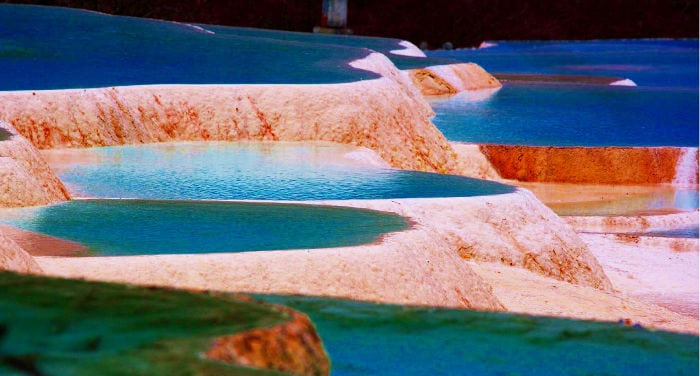
Huanglong (黄龙) is one of the most beautiful natural landscapes in China. Located in the north of the Sichuan province 380 km from Chengdu, it is without a doubt an essential visit in Western China.
The main attraction is the chain of natural pools filled with completely transparent water that run along the Yellow Dragon Valley. These pools offer a unique spectacle of turquoise terraces surrounded by a dense forest. In addition to the beautiful pools, in the nature park, you will find waterfalls and hot springs. In addition, among its fauna are giant panda bears and golden snub-nosed monkeys, a primate endemic to China that is characterized by its golden coat and bluish face. However, the latter are not easy to see.
This beautiful valley surrounded by snow-covered peaks has been a UNESCO World Heritage Site since 1992. Over the past decade and thanks to the huge popularity of the nearby Jiuzhaigou Valley, tourism has developed greatly, eliminating many of the obstacles that made this visit a real odyssey not long ago.
Note: since the earthquake on August 8, 2017, Jiuzhaigou Park will remain closed until the area is completely safe, but the damages in Huanglong were minimal, and it was reopened to the public a few days afterwards.
When to go
The entrance to the Huanglong Valley is located at 3200 meters altitude and the Multicolor Pool, the highest point on the trip, is located at 3570 meters altitude, which means that it has a mountainous climate with very cold winters and mild summers.
During the winter, the lack of rain and the cold tend to empty certain pools, which makes December to April the season during which the landscape is the least appealing. Nonetheless, when the landscape is covered in snow, the blue of the pools stands out even more than during the spring.
In May, the natural landscape regains all of its splendor when the first rains and the thawing of the ice start to provide more water. The pools begin to fill up with clear water and the trees in the dense forest turn green once again.
The high season for visitors starts in June and ends in late autumn, when the pools start to empty due to the lack of water. The months of September and October are the most beautiful, as the forests are filled with red leaves and the likelihood of storms is much lower. Because of this, these tend to be the months when the most tourists go.
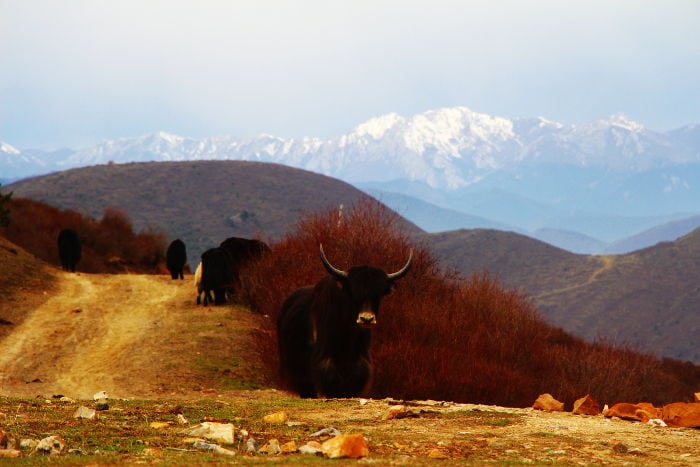
How to get there and get around
Considering that the valley is on the edge of the Tibetan Plateau and far from the main urban centers, the most comfortable way to get there is by plane, although the highway from Chengdu has improved greatly over the past years.
Plane
Jiuzhai Huanglong Airport (九寨黄龙机场) is the main airport in Songpan County and is the best base for visiting both Huanglong and Jiuzhaigou. It’s a small airport that connects the area with Chengdu, Beijing, Chongqing, Shanghai and Guangzhou. During high season, there are also flights from Xi’an, Guiyang and Hangzhou, although these are a lot less frequent. In general, the flights tend to be cheaper from Beijing or Shanghai than from nearby Chengdu, which is an interesting aspect to take into account when planning a trip.
The airport is located 53 km from the entrance to the Huanglong Valley, which means that once at the airport, you need to hire a taxi service to get to the park.
Highway
The highway from Chengdu has improved greatly over the past years, and it’s now possible to cover the 380 km separating the capital from the park in approximately six hours.
Likewise, multiple bus companies offer the trip from the main bus stations in Chengdu, making stops at different urban areas in Songpan County.
Getting around Songpan County
The three main points in the county are the airport, the Jiuzhaigou Valley and the Huanglong Valley. The trip between the entrances to the two valleys is 145 km along the highway (approximately 4 hours). It’s common to visit both valleys during a trip to the area, and given the distances, local transportation is an essential aspect when preparing a trip.
Taxi prices will vary greatly depending on the season, the distance and the days that you hire the taxi, as it’s common to hire a single taxi driver for all of the days during the visit to the area.
Many Chinese websites offer the possibility of purchasing these services in advance, but because the majority of drivers only speak Chinese, I would recommend that you arrange a price with your hotel.
As an example, the most common price that you can get from the airport to the park is around 500 Yuan (one-way), but by purchasing the service in advance and including trips from the airport to Jiuzhaigou, from Jiuzhaigou to Huanglong and from there to the airport once again (4 days total), it only costs slightly more than this amount.
In addition, there is a tourist bus line that services the main tourist attractions in the area.
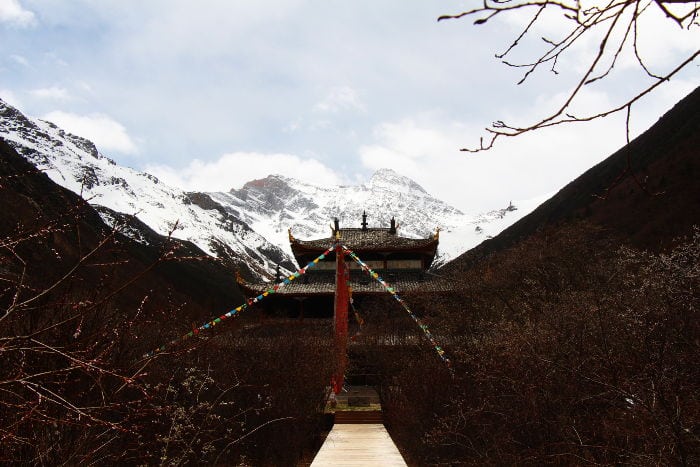
Where to stay
Tourism development in the county has attracted numerous hotel chains and has driven the appearance of multiple guest houses and small hotels. However, given the difficult geographic conditions of Huanglong and the distance from the closest urban areas, the majority of the hotel offering is more than 50 km away.
If you are going to visit Jiuzhaigou in addition to Huanglong, the best option is staying at one of the lodging options located at the entrance to the Jiuzhaigou Valley. There, you will find hotels ranging from the main international chains to cheaper places. The majority of the population in the area is Tibetan ethnicity, because of which the majority of hostels and guesthouses are built in the architecture typical of the area, which is always an extra bonus compared to other, more generic hotels.
If you are only going to visit Huanglong, the best option is to stay in Chuanzhusizhen, the closest city to the valley. It has a few hotels and many restaurants, as well as shopping areas to buy supplies for your visit to the park.
Like in other less-developed areas of China, it’s very important to keep in mind that not all lodging options are allowed to give rooms to foreigners. Don’t forget to check if the place that you are choosing has this authorization to avoid last-minute surprises, especially if you choose one of the cheapest options.
Click here to see hotels in Jiuzhaigou and here to see hotels in Songpan County
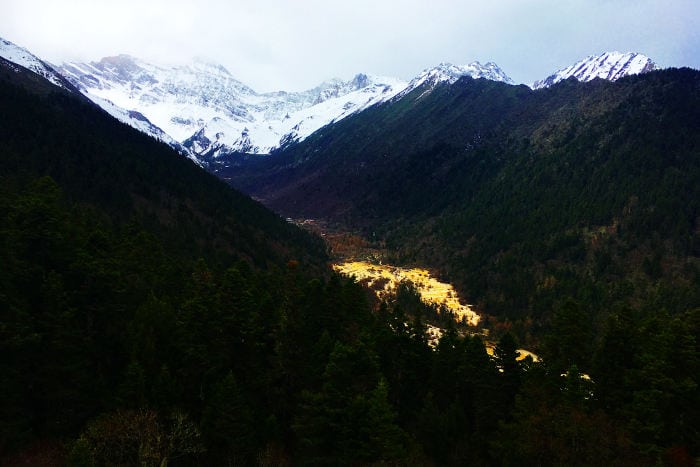
What to do in Huanglong
Even though the protected area is very vast and covers multiple valleys, the main area of interest is the valley that gives its name to the nature park. The Huanglong Valley has a clearly marked trail from the main entrance at the lowest point up to the highest pools, because of which, even though the majority of the information that you will find is only in Chinese, there is no missing it. The entrance to the park costs 200 Yuan from April 1 to November 15 and 60 Yuan during the remainder of the year.
The path from the main entrance to the highest point of the visit is approximately 4 km, with an altitude gain of 370 meters. The entire journey follows cement and wooden paths, because of which, despite the large altitude gain and the continuous stairs, it is perfectly doable. In any event, given that the path up and down is the same, I’m going to tell you about a little trick: if, instead of going through the main gate, you continue 500 meters along the same highway, you will find a secondary gate that has a cable car that will leave you very close to the top. The price is 80 Yuan and it will save you the hardest part of the visit. In the end, you will be able to enjoy the same landscapes on the way down.
The main attractions during the trip are the different limestone formations. When this stone dissolves, its deposits form travertine, a rock with parallel layers and small hollows, with yellow tones and a soft appearance. Under special circumstances, this rock can form pools such as those in Huanglong, which can also be found in Pamukkale (Turkey) or Baishuitai (Yunnan, China). Even though there’s no missing the trail, I will guide you following the waterway, from top to bottom, highlighting the main points of interest:
One of the advantages of going up on the cable car is that when you get there, you will have a panoramic view of the entire valley. During the 500-meter walk along the plain from when you get off the cable car to when you reach the beginning of the visit, you will find multiple viewpoints from which to observe the stark contrast between the white limestone rock, the blue pools and the green forests.
At the end of the walk, you will find yourself on the western edge of the MultiSelect Incecolor Pools (五彩池). This area has more than 700 pools and is one of the most visually appealing areas along the entire trip, as in the pools, you will see the reflections of the snow-covered peaks surrounding the valley, offering a huge variety of colors. There are different viewpoints at different altitudes to be able to enjoy the landscape in its full splendor. I recommend that you go up to the highest point, on the eastern edge of these pools, for the best panoramic views.
Along such a beautiful landscape, naturally there are religious buildings from which to worship the gods protecting the mountains. At the highest point, right at the base of the multicolor pools, you will find Huanglong Ancient Temple (黄龙古寺). Although the area was renovated recently, it’s worth entering, especially to admire its doors, which are a stunning example of Chinese religious architecture. In addition, its views are unforgettable.
The 500 meters separating the Ancient Temple and the Middle Temple (黄龙中寺) are quite possibly the least appealing along the entire path, but don’t get disheartened, because a great spectacle still lies ahead. Surrounding the second temple, you will find a few vendors selling food and oxygen bottles.
Following this small rest stop, some of the park’s main attractions are still ahead of you. The winding path will take you to the expansive Zhengyan Pools (争艳池), to the more stepped Azalea Pools (娑萝映彩池) and to the Reflecting Pool (明镜倒映池), which was given this name because its waters perfectly reflect the mountains surrounding the valley, making it an essential stop.
While going down, don’t forget to glance backwards, as the landscape changes continuously and you will incessantly find unique views following each drop in altitude.
Farther on, a surprise awaits you, as at the Bonsai Pools (盆景池), you will find multiple trees growing in the pools themselves. In the winter, when these trees have shed their leaves and their roots can be seen through the water, they have a mysterious touch that will truly captivate you.
After the spectacle, an impressive change in the landscape takes place: the sedimentary rock ceases to form pools and accumulates more homogeneously, creating a steep wall of travertine known as the Seven Mile Golden Sand (七里金沙). Here, the water falls irregularly and its course can barely be seen.
This bizarre landscape more than a kilometer long is intersected by a few waterfalls, with the
Lotus Platform (莲台飞瀑) being the highest drop at 45 meters, and the Marvelous Flying Waterfall the widest at 68 meters wide.
In this area, which is already close to the exit, you will find some of the largest pools, such as the giant Lianyan Pool (潋滟湖).
Given the distance that separates Huanglong from the airport (1 hour) and from Jiuzhaigou (4 hours), it’s recommendable to set aside an entire day for the visit, especially if you plan to go up and down by foot. As I already mentioned, Huanglong is located at a very high altitude, making it advisable to take necessary precautions against altitude sickness, especially if you have a preexisting medical condition that recommends this. Along the walk, you will find multiple stalls with oxygen bottles, but if you’ve already had a bad experience with altitude, it would be recommendable for you to take your own bottle (you can buy them at the airport as well as any nearby town). Last of all, don’t be deceived by forecasts of sun or nice weather in Jiuzhaigou or nearby towns: Huanglong is located higher up and tends to be rainier, so take warm clothes and rain gear.
In addition to the incredible landscapes in Huanglong, during the trip there, make sure to enjoy the snow-covered landscapes that you will cross. One necessary stop is Xueshan Ridge (雪山梁), where, in addition to the beautiful Tibetan landscape, you will also be welcomed by various birds of prey and a few yaks.
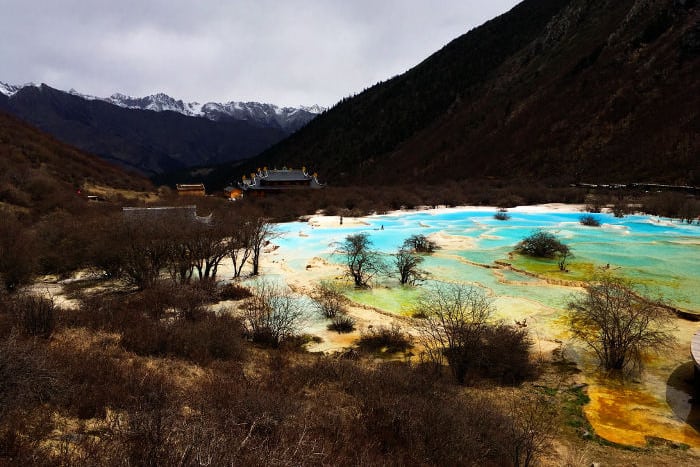
Where to eat in Huanglong
The valley is located in a region that is majority Tibetan, because of which you will be able to try some of the most typical dishes from the area. Tibetan food isn’t particularly varied, and mainly consists of meat (sheep and yak) and grains, with vegetables being a rarity.
The most special dishes are made from yak, including both its meat and milk. Make sure to try momos, the Tibetan version of jiaozi, filled with the meat of this animal. You will also find many skewers with different parts from the yak, dried meat and different types of cheeses.
To drink, laxi, is worth mentioning, which is a yak milk yogurt mixed with honey and Tibetan tea. It’s made from yak milk and has a touch of salt, which tends to give it a very distinctive flavor. It’s the perfect drink if you’re visiting the area in the winter.
Inside the park, you will find a few food and tea stalls, although prices are quite high, making it recommendable to take snacks and drinks for the trip. At the entrance, there are a few restaurants that will make do, despite not being great quality and which, like at any tourist attraction, are overpriced.
Photo Credits: ![]() Huanglong Tibetan dinne by thatkatmat22
Huanglong Tibetan dinne by thatkatmat22



